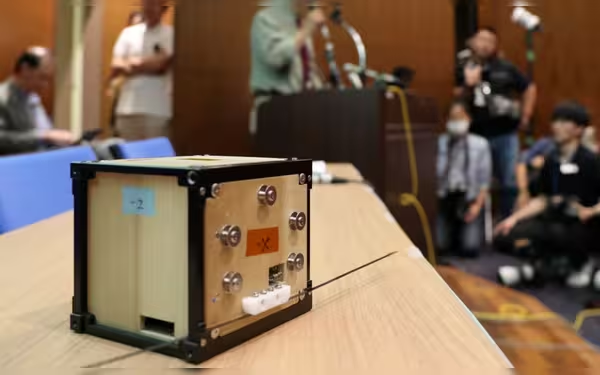Saturday, November 16, 2024 07:56 PM
Japan Launches World's First Wooden Satellite LignoSat
- LignoSat is the first wooden satellite in history.
- Developed by Kyoto University and Sumitomo Forestry.
- Aims to explore wood's potential in space habitation.
 Image Credits: mashable_me
Image Credits: mashable_meJapan successfully launches LignoSat, the world's first wooden satellite, exploring sustainable materials for future space habitation.
In a groundbreaking achievement, Japan has successfully launched the world’s first wooden satellite, named LignoSat. This innovative project, developed by researchers from Kyoto University in collaboration with the construction firm Sumitomo Forestry, aims to explore the potential of using wood in the challenging environment of space. The satellite was sent to the International Space Station (ISS) aboard a SpaceX mission, marking a significant milestone in the field of space exploration.
LignoSat will orbit approximately 400 kilometers above the Earth for a duration of six months. The primary goal of this mini-satellite is to assess the practicality of renewable materials, particularly wood, for future space habitation and exploration. Takao Doi, an astronaut and professor at Kyoto University, believes that wood could serve as a sustainable resource for long-term human settlement in outer space. He stated, "With timber, a material we can produce ourselves, we can build houses, live, and work in space indefinitely." This vision highlights the potential for using natural materials to create a livable environment beyond our planet.
The design of LignoSat is inspired by early wooden aircraft, and it is constructed from honoki wood, which is sourced from a Japanese magnolia species. This type of wood has a historical significance, as it has been used in crafting sword sheaths. The choice of honoki wood was based on a thorough 10-month study conducted aboard the ISS, which demonstrated its resilience in the harsh conditions of space.
One of the remarkable aspects of LignoSat's construction is that it adheres to traditional craftsmanship techniques. The wooden components are assembled without the use of screws or adhesives, showcasing the skill and artistry involved in its creation. Doi and his team have ambitious plans for the future, aiming to deploy timber structures on both the Moon and Mars over the next 50 years.
In addition to its innovative design, LignoSat is being developed alongside a NASA-certified wooden satellite. This collaboration aims to validate the suitability of wood as a material for various space applications. During its six-month mission, LignoSat will face extreme temperature fluctuations, ranging from -100 degrees to 100 degrees Celsius. This will test the wood's durability and performance under such harsh conditions.
Moreover, the mission will evaluate how effectively the wood can shield semiconductor components from cosmic radiation. This information is crucial for designing future data centers in space, where protecting sensitive equipment from radiation is essential for successful operations.
The launch of LignoSat represents a significant step forward in the exploration of sustainable materials for space. As humanity looks to the stars for future habitation, the use of renewable resources like wood could pave the way for a more sustainable approach to living and working in outer space. This pioneering effort not only showcases Japan's commitment to innovation but also opens up exciting possibilities for future space missions.












